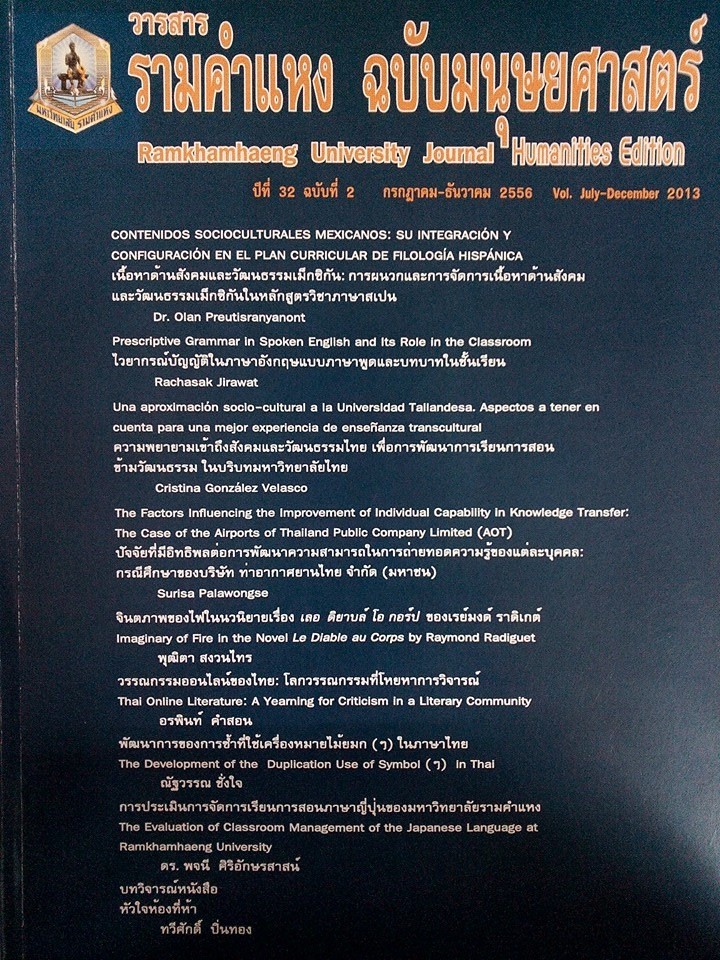การประเมินการจัดการเรียนการสอนภาษาญี่ปุ่นของมหาวิทยาลัยรามคำแหง The Evaluation of Classroom Management of the Japanese Language at Ramkhamhaeng University
Main Article Content
บทคัดย่อ
บทคัดย่อ
การวิจัยครั้งนี้มีวัตถุประสงค์เพื่อประเมินการจัดการเรียนการสอนภาษาญี่ปุ่น สาขาภาษาญี่ปุ่น ภาควิชาภาษาไทยและภาษาตะวันออก คณะมนุษยศาสตร์ มหาวิทยาลัยรามคำแหงและเพื่อหาปัจจัยที่มีผลต่อการพัฒนาการเรียนการสอนภาษาญี่ปุ่น กลุ่มตัวอย่างที่ใช้ในการวิจัยครั้งนี้ ได้แก่ อาจารย์ภาษาญี่ปุ่น นักศึกษาวิชาโทภาษาญี่ปุ่น บัณฑิตที่จบวิชาโทภาษาญี่ปุ่นและผู้ใช้บัณฑิต รวมทั้งสิ้น 118 คน เครื่องมือที่ใช้ในการเก็บข้อมูล ได้แก่ แบบสอบถาม จำนวน 4 ฉบับ สถิติที่ใช้ ได้แก่ ร้อยละ ค่าเฉลี่ย ค่าเบี่ยงเบนมาตรฐาน ค่าที (t – test)
ผลการวิจัยพบว่า 1) การประเมินการเรียนการสอนภาษาญี่ปุ่นทั้งหมด 13 ด้าน ได้รับการประเมินในระดับดี 10 ด้าน ค่าเฉลี่ย 3.69-4.46 ประกอบด้วย ด้านการจัดการเรียนการสอน ด้านการจัดกิจกรรมเสริมการเรียนการสอน ด้านการวัดและประเมินผล สำหรับปัจจัยที่เอื้อต่อ การเรียนการสอน ได้แก่ ด้านอาจารย์ผู้สอน ด้านนักศึกษา ด้านอุปกรณ์ในห้องเรียน ด้านสถานที่เรียน และความสามารถด้านภาษาญี่ปุ่นของบัณฑิตได้แก่ ด้านทักษะการฟัง การพูด และการอ่าน ส่วนการประเมินในระดับปานกลาง 3 ด้าน ค่าเฉลี่ย 3.24-3.44 คือ ด้านอุปกรณ์เสริมให้นักศึกษาเรียนรู้ ด้วยตนเอง ความสามารถด้านภาษาญี่ปุ่นของบัณฑิต ได้แก่ ด้านทักษะการเขียนและทักษะการแปล 2) นักศึกษาให้ความสำคัญกับปัจจัยที่มีผลต่อการพัฒนาการเรียนการสอนมากกว่าอาจารย์ และ 3) การพัฒนาการเรียนการสอน ให้เพิ่มกิจกรรมทั้งในและนอกห้องเรียน เพิ่มสื่อการสอนให้ทันสมัย
เพิ่มวิชาเสริมทักษะในการทำงานและควรสอนวัฒนธรรมและมารยาทของญี่ปุ่น ให้มีการดูงานและฝึกงาน ควรเพิ่มห้องปฏิบัติการทางภาษา เพิ่มหนังสือในห้องสมุดและเพิ่มอาจารย์ทั้งชาวไทยและชาวญี่ปุ่น
Abstract
This research aims to evaluate classroom management of the Japanese language, Japanese section, Department of Thai and Oriental Languages, Faculty of Humanities, Ramkhamhaeng University, and to find factors affecting the development of Japanese teaching and learning. The samples are 118 people consisting of Japanese teachers, students and graduates minor in Japanese, and the users. Four sets of questionnaire are used to collect data which are processed to find percentage, mean, standard deviation, and t-test.
The findings are 1) Ten of the thirteen issues of teaching and learning Japanese are evaluated in a good level with the average of 3.69-4.46. They are teaching and learning management, extracurricular activities, measurement and evaluation, factors contributing to the teaching faculty, students, classroom equipment, classroom atmosphere including graduates’ skills in listening, speaking and reading Japanese. Three issues are evaluated in a medium level with the average of 3.24-3.44. They are self-learning services, writing skills, and translating skills. 2) Students focus the factors that influence the development of teaching and learning rather than a teacher. 3) What should be added to enhance the development of teaching and learning are activities in and outside classroom, modern teaching media, skills courses in working, courses teaching Japanese culture and manners. Also, there should be courses on workshop and internship, a language laboratory, and more teachers both Thai and Japanese.
Article Details

อนุญาตภายใต้เงื่อนไข Creative Commons Attribution-NonCommercial-NoDerivatives 4.0 International License.
ประกาศลิขสิทธิ์จะปรากฏในเกี่ยวกับวารสาร ควรอธิบายสำหรับผู้อ่านและผู้เขียนว่าเจ้าของลิขสิทธิ์เป็นผู้เขียนวารสารหรือบุคคลที่สาม ควรรวมถึงข้อตกลงการอนุญาตเพิ่มเติม (เช่นใบอนุญาตครีเอทีฟคอมมอนส์) ที่ให้สิทธิ์แก่ผู้อ่าน (ดูตัวอย่าง) และควรให้วิธีการรักษาความปลอดภัยหากจำเป็นสำหรับการใช้เนื้อหาของวารสาร


